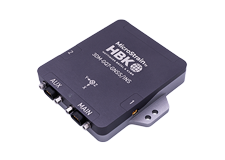MicroStrain 3DM-CX5-GNSS/INS High Performance GNSS Navigation Sensor, OEM Package
The CX product line has all the same features of the GX series in a cost-effective system-integrator friendly package designed for volume production.
There is a newer model of this item:

Tactical Grade Dual Antenna, Multi-band, RTK
Specs
Sensor
- Multi-Constellation receiver tracks up to 32 satellites
-
High Performance Accelerometer
- 25 µg/√Hz (8g option)
- 80 µg/√Hz (20g option)
-
Super-stable Gyro
- 8 dph in-run bias (-40 to +85°C)
- Offset temperature hysteresis 0.05°/s
- ARW 0.3°/√hr
- Pitch-roll Dynamic Accuracy ±0.2°
Operation
- Adjustable sampling rates up to 500Hz
- 34 state auto-adaptive EKF
- Independently configurable IMU, GNSS, EKF outputs
- Forward compatible MIP Protocol optimizes bandwidth
- SensorConnect software for configuration, control, display, and logging
Package
- CNC Anodized Aluminum
- Precision alignment features
-
Highly compact and low profile
- 38.0 mm x 24.0 mm x 11.1 mm
- 13.0 grams
- USB and TTL UART interface (up to 921600 BAUD)
- –40 to +85 °C operating temperature range
- Volume discounts for system integrators
Use Cases
Low-noise, low-drift MEMS gyros and accelerometers result in accurate and robust PVA (Position, Velocity, Attitude) outputs during sharp turns, high winds, etc.
Exceptional IMU performance and robust anomaly rejection by the EKF aids navigation under GNSS outage or denied environments
Fully calibrated and temperature compensated guarantees stable performance in outdoor operating temperature ranges even with high levels of fluctuation
Low-noise, low-drift MEMS gyros and accelerometers result in accurate and robust PVA (Position, Velocity, Attitude) outputs over harsh terrain
Auto-adaptive Kalman Filter algorithms provide exceptional dynamic performance
Exceptional IMU performance and robust anomaly rejection by the EKF aids navigation under GNSS outage or denied environments
Fully calibrated and temperature compensated IMUs provide stable performance in demanding environments
Low-noise, linear, and stable MEMS gyros and accelerometers enable superior heading accuracy during turns & bumps
Auto-adaptive Kalman Filter algorithms provide exceptional dynamic performance
Auto self-calibration and automatic anomaly rejection make units with magnetometer a reliable and accurate heading reference
Fully calibrated and temperature compensated IMUs provide stable performance in demanding environments
Documentation
General Documentation
Downloads
Software/Firmware
More
- Micro D-to-USB Communication and Power Cable
- Micro D-to-RS232 Communication and Power Cable
- Craft Cable with Micro DB9 and Flying Leads
- C-Series Connectivity Board Drawing (STP File)
- Interface Control Drawing
- Dewesoft Inertial Sensor Manual
- 6212-3006 OEM Cable Kit
- 6212-3010 DEVELOPMENT KIT, RS232, INERTIAL C-SERIES
- 6212-3009 DEVELOPMENT KIT, USB, INERTIAL C-SERIES
- 6212-3013 ANTENNA KIT, GNSS, U.FL
Software
SensorConnect
Free
SensorConnect is the next generation in desktop sensing software.
From configuration of nodes and starting networks, to collecting and analyzing data in real-time, SensorConnect provides a modern, powerful experience with our Wireless, Inertial, and Displacement products.
Using our intelligent data collection and graphing algorithms, you are able to visualize massive amounts of data instantly, and then zoom in on points of interest just as fast.
Built in MathEngine functionality allows for both real-time and post-processed math, such as generating FFTs, averages, RMS, etc.

{MSCL}
Free and open source API
The MicroStrain Communication Library (MSCL) makes it simple to write code that interacts with our Wireless, Inertial, and Displacement sensors.
MSCL is completely open source and hosted on GitHub under the MIT license.
Full documentation, example code, and a quick start guide are provided to help you get started.
Available for C++, Python, and .NET.

MIP Monitor
Free Legacy Software
MIP Monitor is PC software specifically designed for our Inertial products.
Configure Inertial nodes, start sampling, and view data in real time.
MIP packets can also be viewed in their raw form to aid in development of custom software.



























